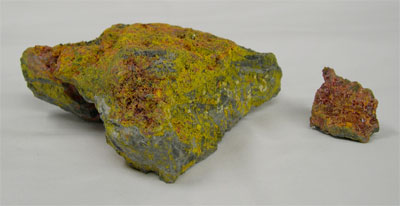Arsenic Toxicity
What is Arsenic?
Course: WB 1576
CE Original Date: October 1, 2009
CE Renewal Date: October 1, 2011
CE Expiration Date: October 1, 2013
en Español
Download Printer-Friendly version [PDF - 1.43 MB]
| Previous Section | Next Section |
Learning Objective |
Upon completion of this section, you will be able to
|
||
Definition |
Arsenic is an element and a naturally occurring mineral found widely in the environment. 
Arsenic mineral ores, orpiment (left) and realgar (right). Environmental sources of arsenic exposure are
Arsenic production has greatly decreased in the United States, but imports of arsenic have increased steadily. |
||
Arsenic Compounds |
Arsenic compounds can be classified into three major groups:
|
||
Classes |
The most common valence states are
The relative toxicity of an arsenical depends primarily on
The toxicity of arsenic compounds can vary greatly. In general, arsenic compounds can be ranked from highest to lowest toxicity:
Inorganic arsenic is generally more toxic than organic arsenic. Forms of arsenic that are more rapidly absorbed are more toxic, while those most rapidly eliminated tend to be less toxic. Arsenite and arsenate forms are highly soluble in water. Although organic arsenicals are usually viewed as being less toxic than the inorganics, several methyl and phenyl derivatives of arsenic that are widely used in agriculture are of possible health concern on the basis mostly of animal studies. Chief among these are monomethylarsonic acid (MMA) and its salts and dimethyl arsinic acid (DMA) and its salts, and roxarsone [ATSDR 2007]. Arsenobetaine and arsenocholine are the organic forms known as “fish arsenic” and are relatively nontoxic to humans. Arsine gas is the most toxic arsenical (acute exposure). |
||
Key Points |
|
||
Progress Check |
|
| Previous Section | Next Section |


